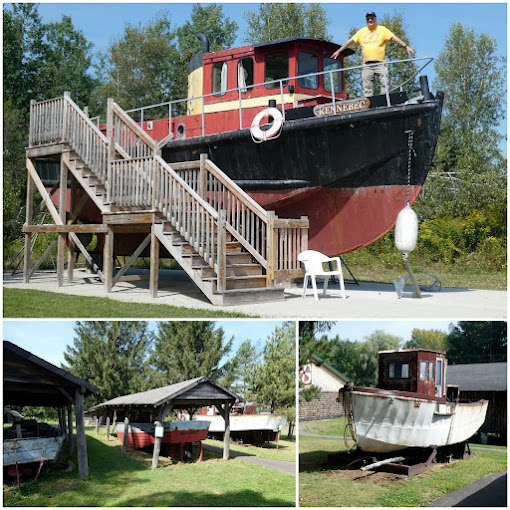The New England Outdoor Center offers three-hour moose and wildlife tours twice daily. Depending on the weather, transportation is either by pontoon boat on Millinocket Lake or van. We had signed up for the 7:00 am tour to increase our odds of seeing wildlife, and we hoped we’d be on the pontoon boat.
When I woke up and looked out the window, I discovered to my dismay that we were completely socked in. I couldn’t even see the lake. I was still game for a tour, but Noreen and Mike decided to skip it. When I walked to the main building and met Ken, our guide, I realized that I was the only one on today’s tour and that we would be going by van.
When I had initially proposed visiting Katahdin Woods and Waters National Monument, I wasn’t sure if Noreen was really up for driving her car on its rough and gravel roads. So, this morning I did some quick thinking and decided to ask Ken if we could go to the monument instead of his normal destination. Ken thought about it for a minute and agreed. He was so easy going and seemed to be up for anything. I figured this might be my only chance to get there, and if Noreen really wanted to visit the monument, I’d be happy to go back.
Katahdin Woods and Waters National Monument was established in 2016 and is a wild landscape within Maine's North Woods and home of the Wabanaki people. The 87,500-acre parcel of land was bought by Roxanne Quimby, the founder of Burt's Bees, who donated it to the United States, along with a $20 million endowment to preserve the park's natural resources. Currently, there are limited visitor services in the park. I love that the NPS website says, “Limited services and signage make visiting an adventure.”
It took almost an hour to get to the monument boundary, so I realized we wouldn’t have time to drive the park loop road. I was just happy to be able to set foot in the park and see a bit of it. One of the first things I had noticed as we drove was the number of anti-park signs. I was familiar with the local opposition, but Ken explained that most locals were starting to come around to the idea.
 |
| Signs of All Kinds |
The roads within the park are used by logging trucks, which have the right of way. We pulled over and allowed one to pass on our way in.
 |
| Logging Truck Without the Logs |
We crossed the East Branch of the Penobscot River, which flows freely through the monument, and Ken shared a wealth of information about the river and the flora and fauna of the Maine Woods. He was a great guide and gave me a better understanding of the region.
Ken decided to turn around at Lunksoos Camps, an old logging compound that is being restored by the park but is marked staff only. We ran into a park employee who was working there, and she told us about the area and the tent campground that had recently opened near the boat ramp.
 |
| Ken and Scenes from Katahdin Woods and Waters National Monument |
 |
| Lunksoos |
On the way out, Ken told me more about Lunksoos, which is best-known by many Mainers as the terminus of 12-year-old Donn Fendler’s arduous nine-day journey from Katahdin while “lost on a mountain in Maine” in 1939. Interesting story! On our way back, Ken asked if I might be up for a wild ride. Of course, I was! We turned onto a four-wheel drive road that’s a much shorter route back to Millinocket. The road is not within the park boundaries, although there is a proposal to incorporate it. The road was rough, but it was fun to see more of the area.
 |
| Sights Along Stacyville Road |
I was never able to see Mount Katahdin at the scenic viewpoints within the park. In fact, I could not see far into the distance at all due to the lingering fog. Still, I’m so glad that Ken agreed to take me to this wild and wonderful place.When I returned to the cabin, Noreen and Mike were up and about, waiting to hear about my journey. They seemed to be just fine with my decision. After relaxing for a while, we decided to drive into Millinocket to have lunch at the Appalachian Trail Café. We stopped next door at the visitor contact station for the park, where I was able to get my passport stamps.
We then decided to go on the drive that Ken would have taken me on this morning. The Golden Road is a scenic North Woods drive, and we stopped at the Abol Bridge Campground where we walked along the footbridge to capture a famous view of Mount Katahdin. Thankfully, the fog had burned off by then.
 |
| An Iconic View of Mount Katahdin |
We spent the rest of the day relaxing along the lake. I think I even took a nap!



















































